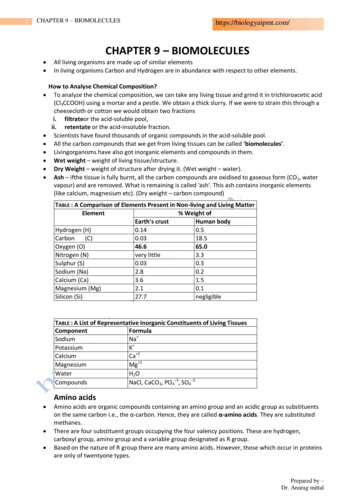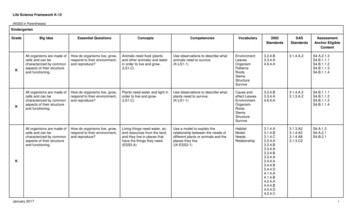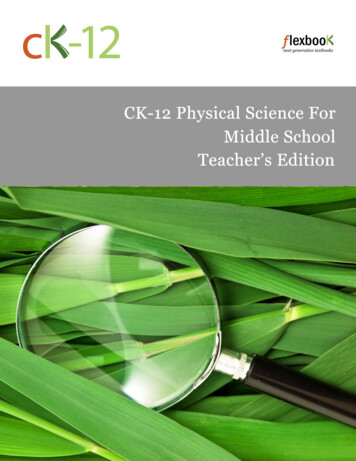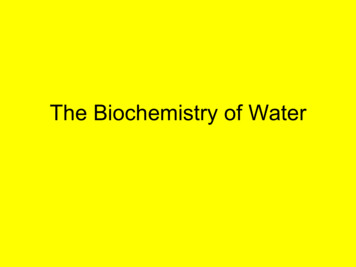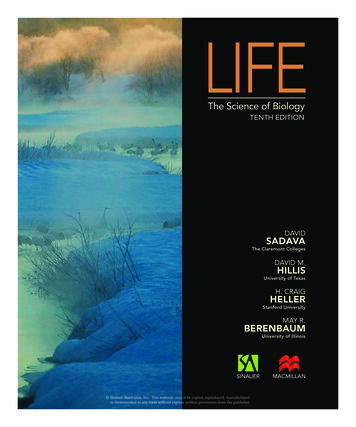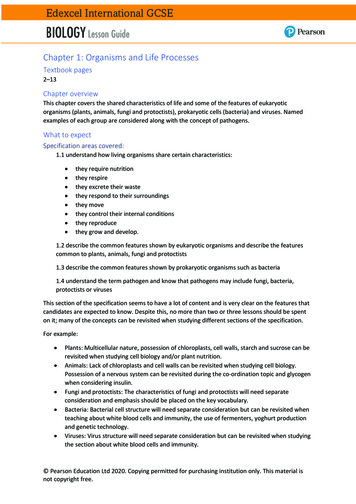
Transcription
Chapter 1: Organisms and Life ProcessesTextbook pages2–13Chapter overviewThis chapter covers the shared characteristics of life and some of the features of eukaryoticorganisms (plants, animals, fungi and protoctists), prokaryotic cells (bacteria) and viruses. Namedexamples of each group are considered along with the concept of pathogens.What to expectSpecification areas covered:1.1 understand how living organisms share certain characteristics: they require nutritionthey respirethey excrete their wastethey respond to their surroundingsthey movethey control their internal conditionsthey reproducethey grow and develop.1.2 describe the common features shown by eukaryotic organisms and describe the featurescommon to plants, animals, fungi and protoctists1.3 describe the common features shown by prokaryotic organisms such as bacteria1.4 understand the term pathogen and know that pathogens may include fungi, bacteria,protoctists or virusesThis section of the specification seems to have a lot of content and is very clear on the features thatcandidates are expected to know. Despite this, no more than two or three lessons should be spenton it; many of the concepts can be revisited when studying different sections of the specification.For example: Plants: Multicellular nature, possession of chloroplasts, cell walls, starch and sucrose can berevisited when studying cell biology and/or plant nutrition.Animals: Lack of chloroplasts and cell walls can be revisited when studying cell biology.Possession of a nervous system can be revisited during the co-ordination topic and glycogenwhen considering insulin.Fungi and protoctists: The characteristics of fungi and protoctists will need separateconsideration and emphasis should be placed on the key vocabulary.Bacteria: Bacterial cell structure will need separate consideration but can be revisited whenteaching about white blood cells and immunity, the use of fermenters, yoghurt productionand genetic technology.Viruses: Virus structure will need separate consideration but can be revisited when studyingthe section about white blood cells and immunity. Pearson Education Ltd 2020. Copying permitted for purchasing institution only. This material isnot copyright free.
Effective homework tasks can include: producing a poster to illustrate the presence or absence of features from each groupproducing a glossary of termsworksheet exercise classifying different organisms based on their photographs.Teaching notes1.1 Characteristics of life This is a very straightforward section. Students need to be able to state the characteristics ofliving things. They could compare how named animals and plants meet the characteristics oflife and why viruses and non-living objects (such as a car) do not.1.2 The variety of living organisms Students can make an A3-sized poster summary chart that lists the presence/absence ornutrition modes of each group. This can be differentiated by either giving them the groupsand asking them to summarise them (high demand) or by giving them the groups and thefeatures with more scaffolding (lower demand).There are terms that many students will not have encountered before, particularly for fungi.Students should make a glossary of terms in their books and if possible add diagrams to helptheir definitions. Key terms that may not have been encountered include: mycelium, hyphae,chitin, extracellular secretion of enzymes, saprotrophic nutrition, plasmid, pathogen, RNA.Bring examples of each group into the laboratory for students to see. Animals and plants areeasy to find. Food that has been left to go mouldy and yeast can be used to demonstratefungi. Protoctists can often be ordered from some biological suppliers or alternatively pondwater can be viewed under the microscope. If none are available, photographs or imagesprojected onto a screen can be used. This topic is best presented visually so that studentscan associate an image with a name or term.Students can be asked to classify a range of organisms that are shown projected onto ascreen. Protoctists with animal and plant characteristics make good discussion points.Students will need to be familiar with the specific examples listed in the specification andunderstand which are pathogens. These include: Fungi (yeast, Mucor), protoctists (Amoeba,Chlorella, Plasmodium), bacteria (Lactobacillus bulgaricus, Pneumococcus), viruses (tobaccomosaic virus, influenza virus, HIV).Students could be asked to make a dichotomous key to classify any of the examples given.Students could test each other’s keys.Possible misunderstandings Many students are not clear that starch is only found in plants while glycogen is found inanimals and fungi.Many students are not aware of the structure of fungi – this should be stressed by theteacher and the mode of nutrition explained. There are time-lapse video clips available onthe Internet that show the growth of fungi on dead plant material, clearly showing hyphaeand mycelia.Students often confuse the terminology. Many students are not aware that the fungal cellwall is made of chitin and mix up HIV with AIDS. Producing a glossary of terms along withshowing the students the structures and organisms is a useful way for them to learn.Students should be clear that pathogens are infectious, disease-causing microbes. Pearson Education Ltd 2020. Copying permitted for purchasing institution only. This material isnot copyright free.
Differentiation When making summary posters of the groups, the amount of scaffolding provided can beadjusted for individual students. More-able students can be asked to produce a summaryposter and find example organisms. Less-able students should be given the features, groupsand examples of organisms and asked to compare the features.When making a glossary, more-able students can be given the required terms and asked todefine them. Less-able students can be given the key terms along with mixed up definitionsand asked to match them up.More-able students could research further examples of each group.PracticalsPracticals listed in the textbookThere are no practicals in this chapter.Additional practicals and demonstrations Demonstrate examples of plants, animals, fungi and bacteria in the laboratory. Fungi may beavailable from shops (edible mushrooms) or can be observed on food left to decay.Protoctists may be purchased from some scientific suppliers or found in pond water.Students can look at fungi and protoctists using microscopes and, if a mixed sample ofprotoctists is available, a classification key can be used to identify some of them.Nutrient agar plates can be used to demonstrate the presence of fungi and bacteria insubstances such as soil and tree bark or on bench surfaces. (The agar plates must not beopened and need to be autoclaved as they may represent a biohazard.) Pearson Education Ltd 2020. Copying permitted for purchasing institution only. This material isnot copyright free.
Unit 1 Multiple-choice questionsAnswers1.2.3.4.5.6.7.8.9.A – nucleus absent, mitochondria absentB – it is a eukaryote and has a cell wall made of chitinD – protoctistsC – fungiB – glycogen in fungi, starch in plantsD–8C – viruses carry DNA or RNAC – bacteria yes, protoctists yes, viruses yesD–4 Pearson Education Ltd 2020. Copying permitted for purchasing institution only. This material is not copyright free.
Unit 1 Multiple-choice questions1. Which row correctly identifies a prokaryotic driaabsentpresentabsentpresent2. The diagram shows a yeast cell.Which of the following statements about yeast is correct?Ait is a eukaryote and has a cell wall made of celluloseBit is a eukaryote and has a cell wall made of chitinCit is a prokaryote and has a cell wall made of celluloseDit is a prokaryote and has a cell wall made of chitin Pearson Education Ltd 2020. Copying permitted for purchasing institution only. This material is not copyright free.
3. The diagram shows a single-celled organism called Euglena.In which kingdom should Euglena be placed?AanimalsBfungiCplantsDprotoctists4. Which of the following can have both multicellular and single-celled organisms?AanimalsBbacteriaCfungiDplants5. Which of the following rows matches the carbohydrate molecule with a correct ngiplantsfungianimals Pearson Education Ltd 2020. Copying permitted for purchasing institution only. This material is not copyright free.
6. Below is a list of the characteristics of ionexcretionnutritioncontrolHow many of these characteristics of life do bacteria exhibit?A5B6C7D87. Which of the following statements about viruses is correct?Aviruses are made of cellsBviruses can reproduce outside the bodyCviruses carry DNA or RNADviruses release energy by respiration8. Which of the following groups contain examples of snovirusesyesnoyesyes Pearson Education Ltd 2020. Copying permitted for purchasing institution only. This material is not copyright free.
9. Below are some statements about fungi.fungal hyphae release enzymes to digest foodthe network of hyphae is called a myceliummany fungi use saprophytic nutritionexamples of fungi include yeast and MucorHow many of the statements are correct?A1B2C3D4 Pearson Education Ltd 2020. Copying permitted for purchasing institution only. This material is not copyright free.
Biology Paper 1 Exam Question Pearson Education Ltd 2020. Copying permitted forpurchasing institution only. This material is not copyright free.
The Mark Scheme Pearson Education Ltd 2020. Copying permitted forpurchasing institution only. This material is not copyright free.
Student Response 1There are more capillaries after training than before. This means that we can runfor longer because more blood can get to the muscles so that they receive morefood and can take away wastes. When we exercise, the heart pumps blood aroundthe body so that the body can do work. If we exercise and work hard, the heartbegins to pump faster and we also breathe faster. This is important because it canmean that the muscles can work faster and with more blood going to the muscles,we can run for longer.Is this a good answer? Pearson Education Ltd 2020. Copying permitted forpurchasing institution only. This material is not copyright free.
Student Response 1: VerdictThere are more capillaries after training than before. This means that we can run for longer becausemore blood can get to the muscles so that they receive more food and can take away wastes. Whenwe exercise, the heart pumps blood around the body so that the body can do work. If we exerciseand work hard, the heat begins to pump faster and we also breathe faster. This is important becauseit can mean that the muscles can work faster and with more blood going to the muscles, we can runfor longer.Could be improvedGood The student has used the data and states that there aremore capillaries after training (1 mark). The student has stated that athletes can run for longer (1mark). The answer generally lacks precision and there are fewmentions of specific factors such as oxygen. Although the student has stated that more blood reachesthe muscles, there is no specific mention of oxygen orglucose transport. The student has not referred to respiration or energy. Muscle activity is mentioned but contraction has notbeen mentioned. There is no mention of removal of carbon dioxide or lacticacid. Much of the answer is irrelevant to the question. Pearson Education Ltd 2020. Copying permitted forpurchasing institution only. This material is not copyright free.
Student Response 1: ImprovementsThere are more capillaries after training than before.The student has correctly identified that training increases the number of capillaries (1 mark).This means that we can run for longer because more blood can get to the muscles so thatthey receive more food and can take away wastes.This lacks precision. The candidate would have gained credit if they had stated that more glucose andoxygen are transported to the muscle and more carbon dioxide is removed.When we exercise, the heart pumps blood around the body so that the body can do work.If we exercise and work hard, the heat begins to pump faster and we also breathe faster.This is irrelevant and scores no credit.This is important because it can mean that the muscles can work faster and with moreblood going to the muscles, we can run for longer.This correctly states that increased blood to the muscles allows means the athlete can run for longer (1mark). Pearson Education Ltd 2020. Copying permitted forpurchasing institution only. This material is not copyright free.
Student Response 2After training, the number of capillaries per mm 2 increased by 23. This means thatmore blood can be transported to the muscles so that oxygen and glucose can betransported faster and wastes such as carbon dioxide can be removed. Aerobicrespiration can occur faster (there will be less anaerobic respiration), making moreATP and meaning that athletes can run for longer. Pearson Education Ltd 2020. Copying permitted forpurchasing institution only. This material is not copyright free.
Student Response 2: CommentaryAfter training, the number of capillaries per mm2 increasedIncrease in number of capillaries has been correctly identified (1 mark).by 23.Although no mark is awarded for it here, it is good practice to quote or manipulate the data.This means that more blood can be transported to the muscles so that oxygen and glucose canbe transported fasterThe substances – oxygen and glucose – transported to the muscles in the blood are correctly identified here (2 marks).and wastes such as carbon dioxide can be removed.Removal of carbon dioxide correctly identified (1 mark).Aerobic respiration can occur faster (there will be less anaerobic respiration),Aerobic respiration correctly identified (1 mark).making more ATPThis is good use of technical language. Although the mark has already been awarded for respiration, it shows a good depth ofknowledge.and meaning that athletes can run for longer.Result is that athlete can run for longer correctly stated (1 mark). Pearson Education Ltd 2020. Copying permitted forpurchasing institution only. This material is not copyright free.
Chapter 1: Organisms and Life Processes – Answers1.KingdomSingle /multi glycogen(heterotrophic)consume otherorganismsyesyes (cellulose)starch/sucrosephotosynthesisnoyes (chitin)glycogensaprotrophic(or parasitic)someyesstarch/(peptidoglycan/sucrose/not cellulose icellularandsingle-celledCell wallCarbohydratesNutritionconsume otherorganismsand/orphotosynthesis2. (a) Order of words: moulds; yeast; photosynthesise; hyphae; chitin; mycelium; nitrogen;enzymes; glucose; amino acids (previous two may be switched); saprotrophic(b) Labels, clockwise from top right: cell surface membrane; cell wall;cytoplasm/glycogen/ribosome; nucleus; mitochondrion; vacuole;cytoplasm/glycogen/ribosome3. (a) Micro-organisms that can cause infections(b)ProtoctistsOrganismDiseasePlasmodium aseinfluenzaflu(c) Viruses are unable to reproduce, grow, gain nutrition, have sensitivity, coordinate, respire,excrete or move independently. Pearson Education Ltd 2020. Copying permitted for purchasing institution only. This material isnot copyright free.
4. (a) Clockwise from top left: slime capsule; DNA/chromosome/nucleoid; cell wall; flagellum;plasmid; cytoplasm; cell surface membrane(b)Prokaryotic cellEukaryotic cellnucleoidproteoglycan cell wallflagellumslime capsuleplasmidribosomecytoplasmcell membrane5. In animals only:nucleuscellulose cell wallchitin cell wall(flagellum on sperm cells)chloroplastmitochondriaribosomecytoplasmcell membranenervous systemIn plants only:starch, sucrose, chloroplasts, cellulose, photosynthesisIn fungi only:single celled, saprophytes, chitinIn animals and fungi:glycogenIn plants and fungi:large vacuoleIn all animals, plants and fungi:multicellular, nucleus, mitochondria6. Movement – use of muscles in animals or slow growth in plantsRespiration – release of energy from foodSensitivity – responding to stimuliGrowth – increasing in size and complexityReproduction – producing offspringExcretion – getting rid of waste productsNutrition – plants make food, animals eat other organismsControl – maintaining steady internal state Pearson Education Ltd 2020. Copying permitted for purchasing institution only. This material isnot copyright free.
Chapter 1: Organisms and Life Processes1. Complete the table to summarise the features of the different kingdoms. State whether organisms are single-celled or multicellular or can be either.State whether chloroplasts are present or absent.State whether a cell wall is present and if it is, state what it is composed of.State the carbohydrate molecules that are present.State the method of nutrition.KingdomSingle / multicellularChloroplastspresentCell sts2.(a) Complete the following paragraph about fungi by using the words in the tosynthesiseamino acidsmyceliumnitrogenchitinFungi are a very diverse group of organisms. Multicellular fungi include , mushrooms andtoadstools. There are also single-celled fungi, such as . Fungi do not possess chloroplasts socannot . Multicellular fungi, such as moulds, produce many fine threads called ,which are coated in a cell wall made of . The whole network of hyphae is called a. Many fungi live on dead material and are very important in ecological cycles such asthe carbon and cycles. They release onto their food which digest it into solublesubstances such as and which they then absorb. This method of nutritionis called nutrition. Pearson Education Ltd 2020. Copying permitted for purchasing institution only. This material isnot copyright free.
(b) Label the diagram of the yeast cell.3.(a) Define the term pathogen. (b) Place each of the listed pathogenic organisms into the correct group in the table and in each casestate the disease they cause. Summarise any information you find about each disease.Try to carry out your own research to add other examples. PneumococcusPlasmodiumtobacco mosaic virus mBacteriaDiseaseOrganismVirusesDisease Pearson Education Ltd 2020. Copying permitted for purchasing institution only. This material isnot copyright free.
(c) Explain why viruses are not classed as living organisms. 4. The diagram shows the general structure of a bacterial cell.(a) Label the diagram of the bacterial cell.(b) Bacteria are called prokaryotic cells. Animals, plants, fungi and protoctists are made of cells calledeukaryotic cells. Place each of the cell structures listed below into the correct columns of the table.Some terms will be included in both columns.nucleusflagellumnucleoidcellulose cell wallslime capsuleplasmidcytoplasmProkaryotic cellchitin cell wallchloroplastproteoglycan cell wallmitochondriaribosomecell membraneEukaryotic cell Pearson Education Ltd 2020. Copying permitted for purchasing institution only. This material isnot copyright free.
5. Place the labels into the correct places on the Venn diagram to show the similarities anddifferences between animals, plants and itinsingle cellednucleusnervous systemmitochondrialarge vacuole Pearson Education Ltd 2020. Copying permitted for purchasing institution only. This material isnot copyright free.
6. Match the characteristics of living things with the correct e of energy from foodrespirationincreasing in size and complexitysensitivityuse of muscles in animals or slow growth in plantsgrowthproducing offspringreproductionresponding to stimuliexcretionmaintaining steady internal statenutritiongetting rid of waste productscontrolplants make food, animals eat other organisms Pearson Education Ltd 2020. Copying permitted for purchasing institution only. This material isnot copyright free.
Chapter 1: States of matterAlignment with Student Book: pages 135–141Chapter overviewThis chapter focuses on the basics of chemistry with an introduction to particles theory. It isassumed that all students will have a working knowledge of solids, liquids and gases. Thechapter will explore the properties of each state of matter but limited to the arrangement,movement and energy levels of particles. The physical properties are not explored.What to expect1.1 Understand the three states of matter in terms of the arrangement, movement andenergy of the particles.1.2 Understand the interconversions between the three states of matter in terms of: the names of the interconversions how they are achieved the changes in arrangement, movement and energy of the particles.1.3 Understand how the results of experiments involving the dilution of coloured solutionsand diffusion of gases can be explained.This chapter is relatively straightforward and builds on much of the work that should havebeen completed during KS3. As some of the content is likely to be revision, a more practicalapproach may be undertaken. Time should be allocated to ensure students grasp thedefinitions of the keywords accurately. A focus on the skill of graph plotting should beencouraged for homework.Teaching notesStarter ActivitiesStates of matter modelling – Give students particle diagrams of the three states of matterand get them to physically model and act out how they would appear. (The teacher shoulduse professional judgement as to how appropriate this activity is for a given class.) Thisactivity can also be used to show the interconversions between states. Pearson Education Ltd 2020. Copying permitted for purchasing institution only. This material is not copyright free.
Changing state card sort – Supply students with cards that have the names of the differentstates of matter and the names of the interconversions on them. The students must arrangethe cards into the correct places. For more able students, add the additional task of givingthree examples of each interconversion. For very gifted students, ask them to identify anoccasion when each interconversion is helpful and an example of when eachinterconversion is a problem.Diffusion activity – Fill seven or eight balloons with air. Give the balloons to students in onecorner of the classroom and say the balloons must not touch the ground and must all stay inthe air for 30 seconds. Students may only tap the balloons with one hand. Start the activity,then after 30 seconds ask students to catch the balloons. The balloons should have spreadout across the class as the students hit them randomly to keep them afloat. Link thedemonstration to diffusion.Demonstration: Diffusion in liquids – Prepare two gas jars or large beakers. Add hot water toone jar and very cold water to the other. Do not tell the students that the water is adifferent temperature. Ask them to predict what will happen when you add a crystal ofpotassium permanganate to the containers. Once you have added the crystals and diffusionhas taken place, ask the students to suggest what they think has happened and why there isa different amount of diffusion in each tube. Hold a thermometer in each tube to show thetemperature difference. This links to energy affecting diffusion.Main activities/practical workDrawing particle diagrams – Either give students a description of the arrangement ofparticles and ask them to draw a diagram of how they think the particles will be arranged.Or give students the particle diagrams and ask them to describe how the particles arearranged. This can be completed alone or in pairs.Practical: Behaviour of states of matter – Students investigate the effect of placing balloonsin water at different temperatures. They measure the circumference of the balloon at roomtemperature and then place it in a water bath containing ice water, warm water, or hotwater for five minutes each time. After each water bath, students re-measure thecircumference. This practical can be linked with the energy the gas particles have and howmuch space they take up. A very simple and quick practical to engage students.Demonstration: Change of state – Heat wax in a boiling tube using a water bath. Record thetemperature every minute or so. Then place the wax in a water bath of cool water. Discussthe state change in relation to temperature and therefore energy. This could be completedas a student practical depending on the ability of the class.Demonstration: Diffusion demonstrations on page 139 of the Student Book – In a fumecupboard, the diffusion of gases can be demonstrated using either bromine, or ammoniaand hydrochloric acid. Both demonstrations are hazardous. If it is not possible to completethese demonstrations then they can be discussed or shown using a video. Pearson Education Ltd 2020. Copying permitted for purchasing institution only. This material is not copyright free.
Practical: Dilution of a coloured solution – Students use pipettes to add 1 cm3 of food dye to9 cm3 of water. They make a dilution series by repeating the procedure of taking 1 cm3 ofsolution to 9 cm3 of water until they can no longer see any dye. Depending on the type offood dye used, the ratio of dye to water may need to be adjusted. More able students maybe able to calculate the percentage concentration at each stage. To make the practical moreinteresting, have a few ready-diluted ‘unknown’ concentration tubes and ask the studentsto use their dilution series to decide on the concentration of the ‘unknowns’.HomeworkAs plotting graphs can be very time consuming, it is advised that these be set for homeworkwhere possible.The TRP homework sheet will also cover much of the content as will the Student Bookquestions on pages 140–141.Possible misunderstandingsStudents often struggle with understanding the difference between boiling and evaporation.They need to learn that boiling occurs when all the particles in a liquid have enough energyto change into a gas, whereas evaporation is when a few particles in a liquid have enoughenergy to change into a gas. A good analogy to use is a football stadium. During a match,there will always be a few people who leave early. This is evaporation. At the end of thematch, when the final whistle blows, everyone leaves in one go. This is boiling.DifferentiationThis chapter provides many opportunities for students to actually complete experimentsand collect data. Equally, where needed, data can be provided to allow students to stillcomplete the analysis required.PracticalsDiffusion demonstrations – the method can be found chlorideDilution of a coloured solution practicalEquipment: food dye, water, 8 boiling or test tubes, 8 pipettes, test tube rack, 10 cm3measuring cylinder, ‘unknown’ samples (if required). Pearson Education Ltd 2020. Copying permitted for purchasing institution only. This material is not copyright free.
Unit 1 Multiple-choice 5.16.17.18.19.20.21.22.D – The particles are arranged regularly and are all touching.D – Particles in a liquid start to change into a gas.D – Nitrogen is found as a liquid on Neptune.C – MeltingD – The time of day they did the investigation.A – The particles are arranged randomly and none are touching.C – Heating the crude oil.C – CrystallisationC – 121–128 CA – NitrogenB – Elements contain equal numbers of neutrons and electrons.B – 2D – NeA – A triple covalent bond.C – A white solid that melts at 750 C and boils at 1360 C.A – In graphite, each carbon atom bonds to three other carbon atoms, forming sheets of hexagonswhich can slide over each other. In diamond, each carbon atom bonds to four other carbon atoms togive a strong structure in three dimensions.D – SiO2A – It has low melting and boiling points.D – 2 D – ZnSO4C – NeonD – 159.5 Pearson Education Ltd 2020. Copying permitted for purchasing institution only. This material is not copyright free.
Unit 1 Multiple-choice questions1. Which of the following best describes the arrangement of particles in a solid?A.B.C.D.The particles are arranged randomly and none are touching.The particles are arranged randomly and are all touching.The particles are arranged regularly and none are touching.The particles are arranged regularly and are all touching.2. Which of the following best describes evaporation?A.B.C.D.Particles in a solid start to change into a gas.Particles in a solid start to change into a liquid.Particles in a gas start to change into a liquid.Particles in a liquid start to change into a gas.3. Nitrogen has a melting point of –210 C and a boiling point of –196 C.Some scientists are testing a spacecraft in different chambers to simulate the effect of aplanet’s temperature on nitrogen.The Jupiter chamber has a temperature of –110 C, the Satur
Practicals listed in the textbook There are no practicals in this chapter. Additional practicals and demonstrations Demonstrate examples of plants, animals, fungi and bacteria in the laboratory. Fungi may be available from shops (edible mushrooms) or can be observed on food left to decay.





